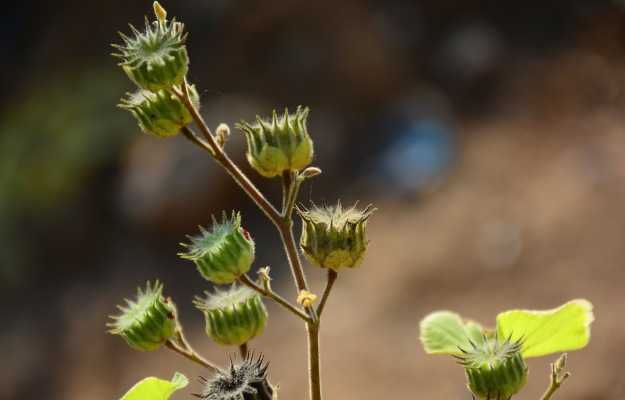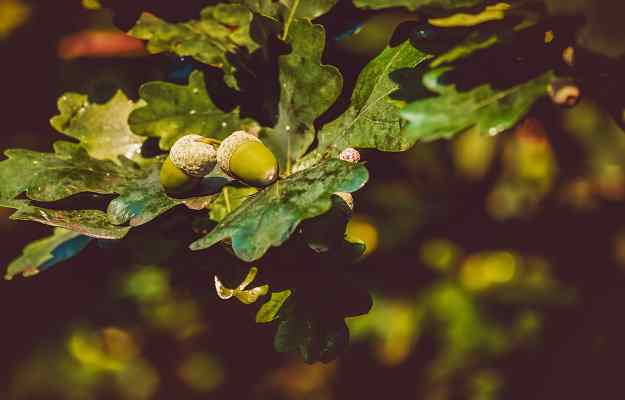Atibala, or Abutilon indicum, is technically a shrub—it is usually 1-1.5 metres but can grow up to three metres tall. Yet it is a well-known component of herbal formulations like Mahanarayana taila for pain relief, Ayurvedic remedies for neuropathic (nerve) pain and a herbal immunity-boosting tonic for children.
Indeed, the plant—recognisable by its distinctive “gear-shaped” seed pods and golden yellow flowers—has been in use in Ayurveda, Siddha, Unani and folk medicine systems for hundreds of years. In Siddha medicine, the whole plant—including the roots—was dried and put to a variety of uses from the treatment of piles to increasing sperm count.
The plant grows easily (even by the roadsides) across India and is widely available in the areas where it is native (Karnataka and Tamil Nadu).
Basic facts about Atibala plant:
- Scientific name: Abutilon indicum Sweet
- Family: Malvaceae
- Common names: Indian mallow, Indian abutilon, Kanghi (Hindi), Jhampi or Badela (Bengali), Jayavandha, Jayapateri (Assamese), Kansaki or Khapat (Gujarati), Shrimudrigida, Mudragida or Turube (Kannada), Kath (Kashmiri), Uram, Katuvan, Urubam, Urabam, Vankuruntott, Oorpam or Tutti (Malayalam), Chakrabhendi, Petari or Mudra (Marathi), Tutti or Thuthi (Tamil) and Tutturubenda (Telugu).
- Sanskrit name: Atibala or Kankatika
- Parts used: Roots, bark, leaves and flowers
- Origins and geographical distribution: Grows across tropical and subtropical regions; but especially Karnataka and Tamil Nadu. The plant can now be found across India and in some parts of Bhutan.
- Interesting fact: The name atibala means great strength.
Writing in the Pharmacognosy Journal in 2010, researchers Anil Kumar Dhiman and Amit Kumar explained: “Balas in ayurvedic literature are used as Balya, or tonic for strengthening the body. Bala, Brela, Atibala, Mahabala and Nagbala belong to the genus Sida of family Malvaceae (which) is in use for medicinal purposes for a long time... Sida rhombifolia Linn. is Mahabala. The other Bala is Atibala, which is botanically known as Abutilon indicum... the Ati means very and Bala means powerful, referring to the properties of this plant as very powerful.”
Read on to know the purported and science-backed benefits of atibala/kanghi plant, standard dosage and potential side effects:
- Atibala (Kanghi) in Ayurveda, Siddha and folk medicine
-
Health benefits of Kanghi (Atibala)
- Kanghi (Atibala) for liver protection
- Atibala for pain relief
- Kanghi plant antioxidant effects
- Kanghi or Atibala lowers blood sugar
- Kanghi uses in gout
- Kanghi or atibala stimulates the immune system
- Atibala for newborn immunity
- Atibala helps fight infection
- Potential use of Atibala in cancer therapy
- Kanghi or atibala dosage
- Kanghi side effects
Atibala (Kanghi) in Ayurveda, Siddha and folk medicine
In traditional and folk medicine, atibala (kanghi plant) was used to treat:
- Piles, due to its action as a laxative (helps in bowel movement) and emollient (something that soothes and softens the skin).
- Dysentery with blood in stool
- Fever
- Allergy
- Infections: Root extracts are traditionally used for bacterial infections and fungal infections, including gonorrhea and bladder infections
- Diuretic: Increases urine production
- Leprosy
- Ulcers
- Headaches
Additionally, it was used as:
- An aphrodisiac, to increase sexual desire
- A heart tonic
Health benefits of Kanghi (Atibala)
As Anil Kumar Dhiman and Amit Kumar point out in their 2010 article in the Pharmacognosy Journal, medicinal plants like atibala (kanghi) have the advantage of having been tried by humans for a long time; so they tend to be safe for most people (check with your doctor before taking herbal medicines, especially if you have a pre-existing condition, or if you are pregnant, breastfeeding, or already taking some medication).
As to how effective they might be, read on to know what science to say about the purported benefits of this particular herb:
Kanghi (Atibala) for liver protection
An animal study (with rats in a lab) showed that the aqueous extract of kanghi plant or atibala—as it is also known—improved liver damage induced by carbon tetrachloride and paracetamol. The scientists suggested that this hepatoprotective (liver protecting) activity could because kanghi extract interferes with the production of free radicals.
Free radicals are unstable atoms that can damage the cells of the liver and cause some liver diseases and fibrosis (scarring).
The scientists also found that a dose of more than four grams per kilogram of body weight was lethal for half the rats in the experiment.
Atibala for pain relief
A study of the phytochemical (plant chemical) composition of Indian mallow root found that a petrol extract contained
- Linoleic acid
- Oleic acid
- Stearic acid
- Palmitic acid
- Lauric acid
- Myristic acid (first isolated from nutmeg in the 1800s) (Read more: Nutmeg benefits)
- Capric acid
- Caprylic acid
These fatty acids are associated with pain relief.
In a lab study with animals, scientists were able to test the effect of eugenol (4-allyl-2-methoxyphenol) extracted from kanghi plant. They found that the pain response of mice exposed to acetic acid reduced by 21.3%, 42.25% and 92.96% at doses of 10 mg per kilo of body weight, 30 mg/kg and 50 mg/kg, respectively.
More research and human trials need to be done to confirm the benefits of kanghi or atibala extracts for pain relief. More research also needs to be done on the quantity and effectiveness of phytochemicals for pain relief in locally sourced extracts of kanghi plants.
Separately, a small study with just 33 patients, conducted over one month, found that 10 grams of atibala root decoction when taken along with another herb, bhumyamalaki (Phyllanthus niruri) helped to ease the pain of diabetic neuropathy and even reverse some of the symptoms.
Kanghi plant antioxidant effects
Research shows that n-hexane and butanol extracts of kanghi plant contain both slow-acting and fast-reacting antioxidants that scavenge (or remove) harmful free radicals like superoxide which are implicated in oxidative damage to tissues and organs.
Additionally, both the aerial portions of the kanghi plant (the part that grows above the ground) and the roots contain flavonoids and phenolic compounds that are responsible for the antioxidant effects.
Further, the researchers found that the free-radical scavenging property of kanghi plants is dose-dependent; that is, the higher the dose, the more effective it is for removing free radicals.
Kanghi or Atibala lowers blood sugar
An experiment with normal lab rats (kept fasting for 18 hours prior) showed that alcohol and water extracts of atibala (kanghi) leaves reduced blood sugar by 23.1% and 26.95%, respectively, after 4-8 hours of administering a dose of 400 mg per kilogram of body weight. More research needs to be done on the effects of kanghi on blood sugar levels in humans.
Kanghi uses in gout
Kanghi leaf extract is known to reduce both acute and chronic inflammation. Researchers found that in samples collected from the Melghat region in Maharashtra, the leaf extracts of atibala could help in human red blood cell stabilization—a standard lab test to check for anti-inflammatory properties. The researchers concluded that the extracts could be helpful to treat some inflammatory diseases like gout.
Further, the researchers said that the leaves contain amino acids, glucose, fructose and galactose; the roots produce a non-drying oil comprising fatty acids like “linoleic, oleic, stearic, palmitic, lauric, myristic, caprylic, capric and unusual fatty acid having C17 carbon skeleton besides sitosterol, and amyrin from unsaponifiable matter”. These plant chemicals could be the reason for the anti-inflammatory properties of kanghi (atibala).
Further, research has shown that the anti-inflammatory properties of atibala may also make it useful in the management of conditions such as arthritis—according to one study, a 100-250mg/mL water extract of atibala reduced protein denaturing and inflammation markers in an in-vitro study.
Kanghi or atibala stimulates the immune system
In a lab study with rats, scientists found that ethanol and water extracts of the leaves of Indian mallow improved specific and non-specific immune response in rats who had been given medicines (100 mg/kg/day of cyclophosphamide and 50 mg/kg/day of levamisole) to suppress immunity.
The scientists dosed the immunosuppressed rats at 200 mg/kg per day and 400 mg/kg per day of Indian mallow leaf extract, before challenging the rats’ immune systems by introducing the red blood cells of sheep. When the researchers used tests like the hemagglutination antibody (HA) titer, delayed-type hypersensitivity, neutrophil adhesion test and carbon clearance test to measure immune response, they found a heightened specific and non-specific immune response in the rats that had been given ethanol or water extracts of kanghi/atibala leaf.
Obviously, studies and trials in human subjects are essential to determine whether this benefit translates in human beings and to determine the safe yet efficacious dosages for people.
Atibala for newborn immunity
In a small study, researchers gave 24 newborns five drops, twice a day, from the 11th day after birth of an oral medicine containing:
- Atibala (Abutilon indicum Linn)
- Amalaki or amla (Emblica officinalis Linn)
- Vidanga (Embelia ribes burn)
- Giloy or guduchi (Tinospora cordifolia Willd Miers)
- Pippali or long pepper (Piper longum Linn)
- Yashtimadhu (mulethi) or liquorice root (Glycyrrhiza glabra Linn)
- Shankhapushpi (Convolvulus pluricaulis Chois)
- Vacha (Acorus calamus Linn)
- Musta or nagarmotha (Cyperus rotundus Linn)
- Ativisha (Aconitum heterophyllum wall)
When the researchers checked the newborns’ blood/serum for immunoglobulins IgG, IgM, IgA after three months and then after six months, they observed a “significant increase'' in immunoglobulins (antibodies) after six months of administering this “Bala compound”. The compound is described by the researchers as part of the Kaumarbhritya branch of Asthanga Ayurveda.
More research is needed on the mechanism and safety of this compound for children. Remember, the World Health Organization recommends that children should not be given anything but breastmilk (or where that is not possible, formula milk) up to six months of age. Typically, children also get all the antibodies they need from the mother’s milk.
Atibala helps fight infection
A lab study using kanghi leaf extract made with carbon tetrachloride “showed statistically significant activity” against both gram-positive and gram-negative bacteria and some fungi. According to the researchers, the extract was moderately “inhibitory” against:
- Bacillus cereus; infection with this bacteria can cause vomiting and diarrhoea
- Pseudomonas aeruginosa, which can cause pneumonia
- Sarcina lutea (M. luteus) which is commonly found in the mouth and upper respiratory tract
- Escherichia coli, which may cause food poisoning in some situations
- Shigella dysenteriae which can cause shigellosis, a type of dysentery
- Aspergillus niger, a fungus also known as black mould
- Candida albicans, a common fungus which can in certain situations cause yeast infections (Candidal infection)
- Trichophyton rubrum, the fungus that is responsible for infections like jock itch, athlete’s foot and nail fungus.
Another lab study of plant samples collected from Sri Lanka found that while kanghi plant extract was somewhat effective against the bacteria the researchers were using for the experiments (including M. phylei, a non-tuberculous mycobacterium), it was definitely not as effective as some other plants like Clerodendrum infortunatum (bhandira) and Syzygium cumini (jamun).
Potential use of Atibala in cancer therapy
Scientists have been using plants to create metal nanoparticles for a variety of pharmaceutical and other uses. A lab (in-vitro) study on “green synthesized gold nanoparticles”—as the creation of gold nanoparticles using “green chemistry” is known—using atibala, attributed “anticancer activities”, specifically against colon cancer, to these particles.
It is still early days for this therapeutic technique, and this study was conducted purely in a lab environment. Much more research and human trials will have to be done before the therapy can become available to people.
Kanghi or atibala dosage
The dosage may vary depending on your needs and overall health, and can be recommended by a trained doctor. Having said that, the standard dosage given in The Ayurvedic Pharmacopoeia of India (by the AYUSH ministry) is 3-6 grams of Atibala powder.
Kanghi side effects
Though no significant side effects of kanghi are reported in the literature, it’s important to consult your doctor before taking any herbal medicines.
If you have low blood sugar, or are breastfeeding, please note that there isn’t enough scientific research on how atibala extracts could affect your health—you should not take this herb in any form unless it’s recommended by your doctor.
Traditionally, the herb was used to improve fertility in women. Some small studies have been done on the usefulness of atibala to enable conception, sustain pregnancy in cases of recurrent miscarriage and promote fetal growth, but these studies are few and far between. The conditions of some of these experiments could also be suspect—please do not take herbal medicines without the recommendation of your doctor.
Find Naturopathy Doctor in cities
Doctors for Atibala benefits and side effects

Dr. Reena Mudiya
Naturopathy
5 Years of Experience

Dr. Ekta Gupta
Naturopathy
5 Years of Experience
Medicines / Products that contain Atibala
- Myupchar Ayurveda Kumariasava 450ml - ₹379
- HASS Lakshmivilas Rasa (Nardiya) (80 tab of 250 mg each) - ₹220
- Prima Ortho Joint Oil - ₹150
- Baidyanath Nagpur Brahmi Bati Smay (30) - ₹1088
- I-Red Tilla oil - ₹1399
- HASS Lakshmivilas Rasa (Nardiya) (40 tab of 250 mg each) - ₹105
- Himalaya Stress Relief Massage Oil - ₹123
- Himalaya Pain Relief Oil - ₹95
- Baidyanath Swarna Shakti Ras - ₹720
- Ayurveda Yogashram Remedies Sino Heal Capsules (90) - ₹1090
- Himalaya Diabecon DS Tablet - ₹152
- Baidyanath Nagpur Brahmi Bati Smay (5) - ₹227
- Baidyanath Nagpur Brahmi Bati Smay (10) - ₹405
- Joyveda Diabetes Care Capsule - ₹2700
- Joyveda Female Fertility Capsule - ₹5400
- Shuddhi Weight Gain Package - ₹4800
- Vaidyaratnam Sundheebaladi Kashaya Choornam - ₹68
- Deep Ayurveda Shatavarayadi Churna 100gm - ₹235
- Vaidyaratnam Shundheebaladi Kashayam - ₹133
- Vaidyaratnam Supthi Thailam - ₹120
- Vaidyaratnam Kethakeemooladi Thailam 200ml - ₹150
- Deep Ayurveda Punarnavadarishta 450ml - ₹195
- Vaidyaratnam Kethakeemooladi Thailam 450ml - ₹231
References
- N.L. Dashputre et. al. Immunomodulatory activity of 'Abutilon indicum' Linn on albino mice. International Journal of Pharma Sciences and Research (IJPSR), 2010; 1(3): 178-184.
- National Health Portal [Internet]. Atibala, 19 November 2015.
- Y.N. Seetharama, Gururaj Chalageri, S. Ramachandra Setty, Bheemachar. Hypoglycemic activity of 'Abutilon indicum' leaf extracts in rats. Fitoterapia, 2002; 73:156-159.
- Britton R.S. and Bacon B.R. Role of free radicals in liver diseases and hepatic fibrosis. Hepatogastroenterology, August 1994; 41(4): 343-8. PMID: 7959569.
- E. Porchezhiana and S.H.Ansari. Hepatoprotective activity of Abutilon indicum on experimental liver damage in rats. Phytomedicine, 10 January 2005; 12(1–2): 62-64.
- Ahmed M., Amin S., Islam M., Takahashi M., Okuyama E. and Hossain C.F. Analgesic principle from 'Abutilon indicum'. Pharmazie, 2000; 55(4): 314-316 ref.11.
- Patel K., Patel M. and Gupta S.N. Effect of Atibalamula and Bhumyamalaki on thirty-three patients of diabetic neuropathy. Ayu, July 2011; 32(3): 353-6. doi: 10.4103/0974-8520.93913. PMID: 22529650.
- Appaji R.R., Sharma R.D., Katiyar G.P. and Sai Prasad A.J.V. Clinical study of the immunoglobulin enhancing effect of “Bala compound” on infants. Ancient Science of Life, January-March 2009; 28(3): 18-22. PMID: 22557316; PMCID: PMC3336317.
- Rajurkar R., Jain R., Matake N., Aswar P. and S.S. Khadbadi. Anti-inflammatory action of 'Abutilon indicum (L.)' Sweet leaves by HRBC membrane stabilization. Research Journal of Pharmacy and Technology (RJPT), April-June 2009; 2(2): 415-416.
- T. Shekshavali and Dr S. RoshanResearch. A review on pharmacological activities of 'Abutilon indicum' (Atibala). Journal of Pharmacology and Pharmacodynamics, October-December 2016, 8(4): 1-4.
- Mata R., Nakkala J.R., Sadras S.R. Polyphenol stabilized colloidal gold nanoparticles from Abutilon indicum leaf extract induce apoptosis in HT-29 colon cancer cells. Colloids and Surfaces. B, Biointerfaces, 1 July 2016; 143: 499-510. doi: 10.1016/j.colsurfb.2016.03.069. Epub 26 March 2016. PMID: 27038915.
- Muhit Md. Abdul, Apu Apurba Sarker, Islam Md. Saiful and Ahmed Muniruddin. Cytotoxic and antimicrobial activity of the crude extract of 'Abutilon indicum'. International Journal of Pharmacognosy and Phytochemical Research, 2010; 2(1):1-4.
- Rajakaruna N., Harris C.S. and Towers G.H.N. Antimicrobial activity of plants collected from serpentine outcrops in Sri Lanka. Pharmaceutical Biology, 2002; 40(3): 235-44.
- Rajakaruna N., Harris C.S. and Towers G.H.N. Antimicrobial activity of plants collected from serpentine outcrops in Sri Lanka. Pharmaceutical Biology, 2002; 40(3): 235-44.
- Yasmin S., Kashmiri M.A., Asghar M.N., Ahmad M., Mohy-ud-Din A. Antioxidant potential and radical scavenging effects of various extracts from 'Abutilon indicum' and 'Abutilon muticum'. Pharmaceutical Biology, March 2010; 48(3): 282-9. doi: 10.3109/13880200903110769. PMID: 20645814.
- Department of AYUSH, Government of India [Internet]. Atibala. In "The Ayurvedic Pharmacopoeia of India Part 1, Volume 1".














